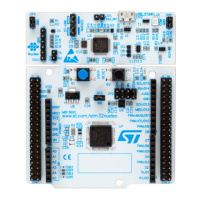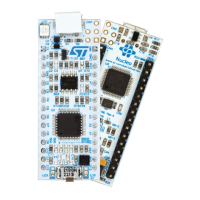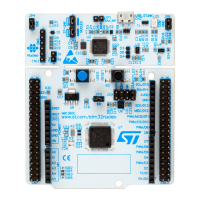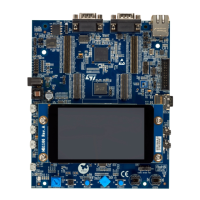6.2 Clocks
Two clocks are available on STM32MP157F-EV1 for the STM32MP157FAA1 target microprocessor.
6.2.1 LSE clock
• External 32.768 kHz crystal
6.2.2 HSE clock
• External 24 MHz crystal
6.3 Reset sources
The reset signal of the STM32MP157F-EV1 platform is active low.
The sources of the platform reset are:
•
Two reset buttons MB1263/B1 and MB1262/B2 (black buttons)
• STM32MP157FAA1 microprocessor: internal voltage monitor, SW request or watchdog
• STPMIC1
• JTAG/SWD connector MB1262/CN14
• ETM Trace Mictor-38 connector MB1262/U10
• Embedded ST-LINK/V2-1
The STM32MP157FAA1 microprocessor also drives a subsystem reset, SUB_NRST signal on PD10 IO, to the
peripherals: USB Host Hub, MFX, Ethernet, and RGB_LTDC connector.
6.4 User buttons and LEDs
Table 8 describes the HW configuration for the user buttons and LEDs.
T
able 8. HW configuration for the user buttons and LEDs
I/O LED color and label Button label
PD8 PD8 is connected to the orange LD4. Active High -
PD9 PD9 is connected to the blue LD5. Active High -
PA13 PA13 is connected to red LD2. Active Low User PA13
PA14 MFX_IO13 is connected to orange LED LD7. Active Low User PA14
6.5 Physical input devices: buttons
The STM32MP157F-EV1 board provides a number of input devices for physical human control:
•
Two reset buttons (MB1263/B1 and MB1262/B2)
• Four-way joystick controller with select key (MB1262/B1)
• Wake-up button (MB1263/B4)
Table 9. Physical user devices: buttons
Devices Purpose - I/O
Wake-up button (MB1263/B4)
Awakes the platform from low-power modes.
Connected to
STPMIC1 PONKEY, which
generates a wake-up signal on STM32MP157
PA0
Reset buttons (MB1263/B1 or MB1262/B2) NRST signal
JOY_CENTER: Joystick select key (MB1262/B1 pin2) MFX_IO0
JOY_DOWN: Joystick down direction (MB1262/B1 pin3) MFX_IO1
UM2648
Clocks
UM2648 - Rev 1
page 13/61
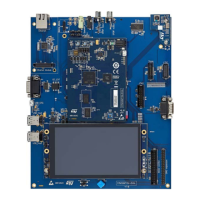
